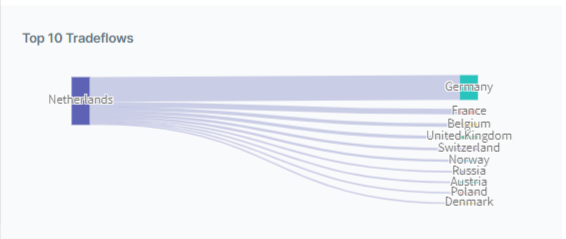Strong Demand for Mangoes in European Market as Summer Approaches

According to Alicia Abendroth, Tridge Engagement Manager, Germany, there is currently a great demand for mangoes, pressuring mango wholesale prices. According to data from Tridge, wholesale mango prices in W2 of June ranged from USD 3.56/kg in Portugal, then USD 3.68/kg in Spain, to a whopping USD 7.88/kg in France. Usually, for this period, from April to June (week 16 to week 26), large shipments of mangoes arrive from Ivory Coast and Senegal. In addition, Brazil and the Dominican Republic are critical players in supplying mangoes to the EU. However, the quantities currently coming on the market are significantly below the average, creating a shortage in mango supply in the EU market.
The combination of weather conditions and economic influences contributed to the current mango shortage in Europe. In Senegal, mango blossoms started later than in 2021 because of lower temperatures. As a result, the harvest is expected to be postponed, and the first shipments will arrive around week 28. The situation in the Ivory Coast also took part in climate changes, where unfavorable weather conditions in the form of heavy rains led to an earlier end of the season, with the last deliveries arriving in W5 of May. On the other hand, mango exports from Brazil have been vigorously shaken by climatic and economic factors. Heavy rains that hit the São Francisco Valley between December 2021 and April 2022 significantly damaged mango orchards. Farmers faced additional production costs such as more pesticide treatments followed by increased prices of both pesticides and fertilizers and had to invest additional funds in orchard cover and land drainage.
Brazil's traders emphasized the sea freight price increase by more than 60%. The regular shipments from Brazil to the EU in this period are 120-150 containers; however, due to a lack of vessels and high transport prices, delivery dropped to 50-70 containers per week. In addition, Dominican traders could not deliver the required quality from Dutch customers, which caused many producers to shut down export because of costs exceeding returns.

Source: Tridge
The Netherlands is the central hub for the mango trade in Europe. There has been a steady increase in mango imports over the past five years by as much as 32.49% to 249,331 mt in 2021. Furthermore, the total Mango Exports from the Netherlands amounted to 226,149 mt, meaning that over 90% of imported quantities were redistributed. The main markets are Germany and France (cumulatively imported 117,645 mt from the Netherlands). At the same time, Portugal in Europe is the largest mango consumer per capita, with an average consumption of 2.2 kg per year and an import volume of 27,413 mt of mangoes.





